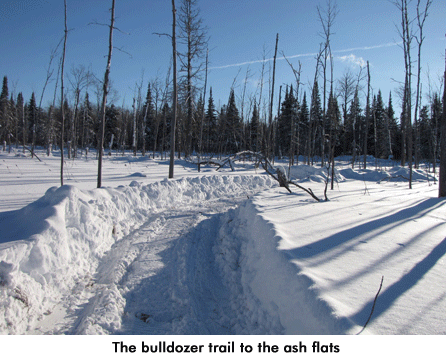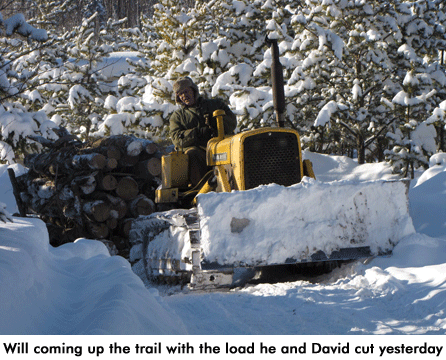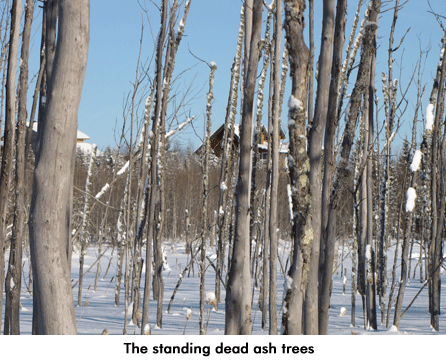We’ve had a cold snap, with more snow and bitter cold on the way. But the sun has been shining, and Will and David went out across the creek with Old Yeller, our trusty John Deere 1010 crawler, to cut some of the dead ash trees that the beavers, by building their dam higher, flooded and killed about 15 years ago. About all you can see is the smaller, standing dead trees, but Will discovered that UNDER the two feet of snow, were lying large, rock hard dead ash trees that the beaver had actually cut way back when.
So he developed a system of plowing a section with the bulldozer blade to root up and pull up the downed trees. Then he hauled tree lengths out to our new $75 steel firewood sled. He and David cut the trees into 8-foot lengths to fit on the sled, then loaded them. In about 1½ hours, they harvested a cord of the most beautiful ash firewood ever.
The day before, David was in school and Will started by himself and got pretty tired (4 hours), but brought home a cord and a quarter. We cut up some of the smaller standing dead trees, and we’re amazed at how the pieces caught fire instantly in the stove and burned like coal. This is after standing outside for months in the rain, then in the snow!
We’d like to know just how many cords of good wood are lying out there; years’ worth, for sure! At this rate, and after that -27° weather they’re predicting, we will soon have next winter’s firewood all up in the yard; and that’s not counting the wood stacked down in the horse pasture from our big woods. We feel truly blessed!
Readers’ Questions:
Storing layer feed
With corn prices rising so dramatically, I would like to purchase extra layer feed to have on hand for our 15 chickens. However, I am concerned about it keeping well. We could freeze it for now, but that is not dependable in case of a power outage (or worse, a natural disaster). Would it be possible to can the layer feed pellets in quart-sized jars so that it would last a year or more?
Kristen Seine
Wasilla, Alaska
If you keep your layer feed in a moisture-proof container, it will remain good for longer than a year. I’d suggest a 55-gallon drum with a cover or rodent-proof garbage cans. You don’t need to process (can or freeze) your feed so you’ll save plenty of work. Your hens will love you for your thought to their well being! — Jackie
Burning paper and store-bought lard
Hello, I have a couple of brief questions. I started burning my (mostly) paper trash last year. After one year I have ½ of a metal burn barrel of grey powdery ash. Would it be advisable to add this into the mix when filling my newly made raised beds? I will be growing an assortment of vegetables there. Or will it be better to just spread it elsewhere?
On another note, store-bought lard is different than home rendered lard, I know. Does store-bought lard need refrigeration? It doesn’t say to refrigerate after opening on the can.
Mary Hartsock
Lancaster, Kentucky
If you didn’t burn colored paper or “shiny” advertisements, both of which contain heavy metals, you can use a moderate amount in your raised beds, turned in well. Of course, ash is alkaline and a good soil test would be recommended before adding it. If your soil is already alkaline, do not add the ash or your plants will not do well.
Store-bought lard does not need refrigeration, but if it is left out at room temperature too long, it will get rancid, as will vegetable oil and shortening. Refrigeration will make it remain good longer; just cover it to avoid picking up unwanted refrigerator smells. — Jackie
Homemade blood meal
I’ve started to save the blood from when I butcher a lamb. Last time I cut the coagulated blood into squares and froze them for dog treats. Next time I’d like to dehydrate the blood to make blood meal to add as a soil amendment. Do you know if this is possible and, if so, how I would use my Excaliber dehydrator to do the job?
Carol Elkins
Pueblo, Colorado
I would think that you can just lay your squares of coagulated blood on fruit leather trays in your dehydrator and treat it as if you were drying jerky, only drying it crisp instead of leathery. Then whiz chunks in your blender to create a powder. Do be careful and wash your equipment well with soap and water as blood is a good media for bacteria to grow in, whether in a dehydrator or blender or cut. — Jackie
Peeling carrots
Here is something you might tell others. I have been canning carrots from my garden for a while and the peeling of them took so long and wasted so much so I got to thinking and went out to my garage and got my wood rasp and started peeling the carrots. WOW!! did it work good. I had to put water in my sink and keep rinsing the wood rasp because it filled up quickly but a quick dip in the water and it cleans right off. Also very very little waste. It leaves the carrot a little fuzzy when canned they look fine.
Jay Babb
Loomis, Washington
Good tip, Jay. I quit peeling my carrots, too. Now I just scrape them with a sharp paring knife. I also found out that the sweetest part of the carrot is right under the peeling, which we cut off when we peel carrots. So I cut down on my work and waste, also, and have sweeter carrots. Thanks for the tip. — Jackie






I like the pictures of the wood hauling operation. I will have to check back more often. Nice to see the sled working.
Comments are closed.